
Tuesday 27th January Off to Lanzarote bright and early 10 km
We had a view to the monument and looked out onto flat country dotted with volcanoes. Jurgen had wheeled his wife Elke around – she was in a wheel chair.
Adrian was feeling a bit worse for wear, with a cold, and after our early start, so he caught up with a bit of sleep while I got settled in.
When we'd found homes for everything, we had a cup of tea sitting outside. Jurgen had bought over a (new) kettle.
We then set off on a walk around the village, looking in at the restaurant which Elke had mentioned. It looked pleasant, but no good for tonight, as it was closed on Tuesdays! We really enjoyed the multitude of large, different cacti, both in the garden and around the village.

Lunch on the patio
Also we saw a variety of exotic flowers – bougainvillea, plumbago, strelitzia. The sun was nice, but we didn't like the strong cool wind. We had looked into a little swimming pool at the house, in a sort of 'grotto', but the water was disappointingly cool, unlike the one in Tenerife.
The road near the house was unpleasantly busy, but we enjoyed the little white houses with their green doors and window frames. This is another of Manrique's legacies – he didn't want Lanzarote to have high rise buildings, and wanted the houses to keep to the traditional colours.
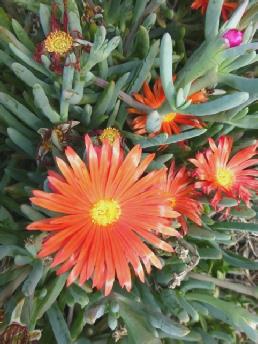
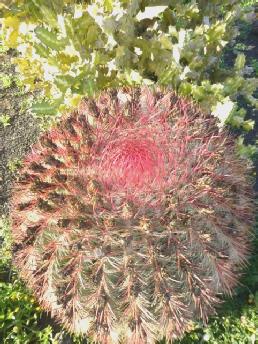
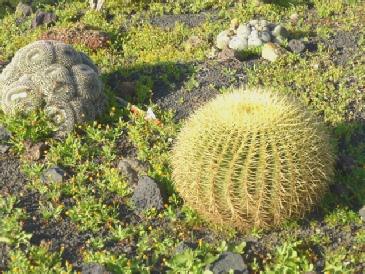
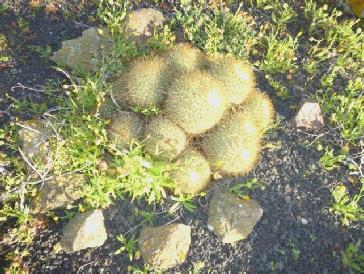
Wednesday 28th January Nice views in the north 91 km
We woke late after a disturbed night due to Adrian's cough. We were disappointed to see that the morning was cloudy and windy – not what we'd ordered at all! We couldn't get the radio to work on the computer as the connection wasn't good enough.
The sun was peeping through as we had breakfast, but with no toaster it was 'bread and marmalade' for Adrian.
We got organised to go out in the car, leaving at 11 o'clock after having coffee/tea on the patio.
We drove towards Teguise, being surprised at how green everywhere was compared with the barren desert we had been expecting. We passed some cyclists - the first of many today. Lanzarote must be prime cycling country like the other Canary Islands.
We enjoyed seeing the red flowering aloe, looking a bit like red hot pokers. Later we saw yellow ones too. Also there were red geraniums, typical of the island.
We stopped at the attractive town of Teguise, painted in the traditional colours of white and green. There were a lot of tourists shops and tourists - English and German. We looked inside the wide, airy church of Our Lady of Guadalupe. It was all really pleasant, but the temperature was too cold for me!
We stopped at the very English bakery and bought an expensive loaf of bread for lunch.
We drove on north to the Mirador de las Nieves, next to a nice hermitage. There were great views down over the steep west coast. Lots of brave little flowers covered the barren rocky ground. We ate our lunch in the car - not an easy task - before walking around the outside of the hermitage. There were views to the coast on both sides of the island, which is quite narrow at this point. Little plants were growing out of the trunks of the palm trees.

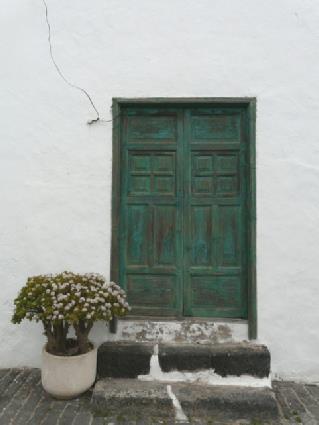
Images of Teguise
We now wound down on many hairpins past the terraced hillsides to Haria. This was another white and green village, but didn't have the attraction to us of Teguise. There were plenty of restaurants and boutiques. It was a coach stopping point, so was catering for the masses! We passed a chemist and were able to buy some cough mixture for Adrian. As we got back to the car the sun came out - what a difference - it felt warm!

Hermitage de las Nieves
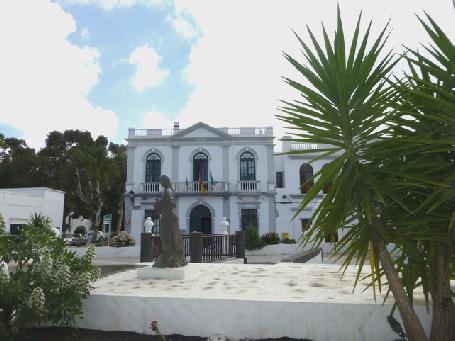
Haria
We drove on north to the viewpoint you are meant to see - the Mirador del Rio. We had to pay €4.50 each for this. It is one of Manrique’s creations, and although attractive, set in a sort of cave, gave no better views than the previous viewpoint, and was, as Adrian said, an expensive toilet stop!
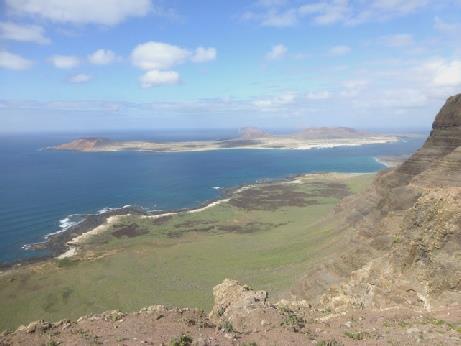
Looking to the island of Graciosa from Mirador de Guinate
We now drove back south on a 'fast' road, turning off to Teguise Playa where Adrian was hoping to locate a large supermarket to buy a light bulb and a corkscrew. This was a real tourist area, with people dressed in holiday gear whatever the weather, although it was a bit warmer here than higher up.
We eventually stopped at another Spar supermarket, where we didn't get any of the things Adrian had wanted, but did get some washing up liquid, kitchen roll, and some sherry for me. A bit further on, we passed a 'bricolage', where Adrian did buy a stronger light bulb, which he managed to fit when we got back – the existing one was like a candle!.
It was 5 o'clock when we got back. Adrian went to ask Elke about a hair-drier, which it said on the info was here. He didn't succeed with that, but did come back with a toaster! A bit later, as we sat with our aperitif, the lady from next door brought us a hair-drier, wishing us a pleasant evening (she didn't speak English, and would appear to be German too.)
We had decided to try out the restaurant in the village - Caserio de Mozaga - tonight so braved the cool blowy evening to walk there. It was a smart place, nicely done out. There was a wood burning stove, which we thought that we'd sit near, but when the waiter asked if we'd booked, and we said no, we were directed to a table away from the fire. There were several other diners.
The evening wasn't the greatest success. Our meals of pasta (A) and veggie rice with prawns(R) were OK, but we felt 'Come back Romania & Bulgaria', where prices were so reasonable that it made eating out a pleasure! The wine was extortionate, so we settled on a beer each. Probably Adrian's unpleasant cough made us see everything in a poor light!

Panorama from Mirador del Rio
Thursday 29th January Sites of the south west 64 km
We both slept much better - perhaps Adrian's cough mixture helped.
We were late getting going. We had decided to try out the shower, but like everything here it had its problems, the shower head didn't stay up and the towel rail fell down when we touched it! We felt a bit like Frank Spencer, when everything we touched fell apart!
The sky was disappointingly overcast, and it stayed that way all day. Adrian was struggling to feel enthusiastic! At least we could have toast for breakfast this morning, which was nice!
We didn't leave until late morning. We had decided to visit some of the sites in the south of the island, setting off south-westwards through the amazing fields of lava.
This area is know as la Geria, and is where Lanzarote wine comes from. The 'vineyards' are nothing like we are used to. The vines are grown in the lava, with a little semicircular wall surrounding each plant. It was a really strange sight, and unbelievable that wine could come from this! The area is extensive, with many 'bodegas' along the way.
We didn't stop, except to take photos, continuing past Uga to Yaiza. This is Lanzarote's 'model village', being as Manrique had wanted all villages to look like. It didn't really grab us. The constant white and green can be a bit too much. We sympathised with Emma, who as a child had found our neighbouring village of Yattendon, which has all green paintwork, too uniform.
We parked by the church of Remedios, which had a small square to front and rear. Inside the church was very atmospheric. The altar, with statues of both Mary and Jesus, was in white and blue, and was lit up, although the rest of the church was dark. Peaceful music was being played - we thought that more churches should do this.

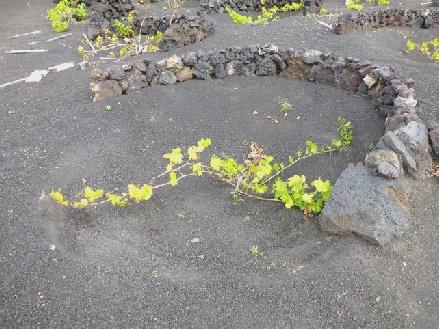
La Geria ‘vineyards’
We wandered around a bit. There were a few tourist shops in what was called 'Artisans', but again this village was a coach stopping place, and in the cool and grey we didn't find it very exciting.
On the way out of the village we stopped by the 'aloe vera' museum. There was a lot of information on aloe vera and its many uses. Descriptions were in English, and we watched a film about aloe vera. We realised that this was the plant we'd been seeing, with its yellow spikes – we had forgotten. We have visited an aloe vera 'farm' in South Africa. There were of course products to buy, and we did get a couple – skin products which we'd wanted.
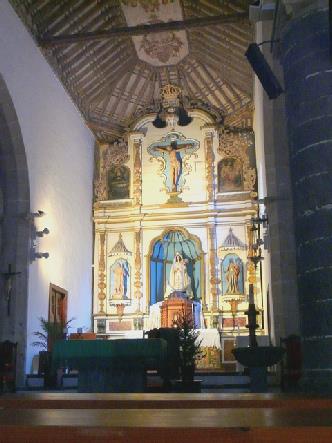
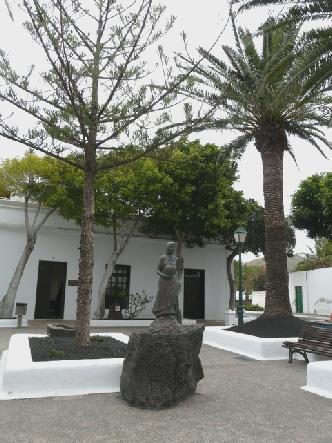
Yaiza
Again there were lots of visitors, but the spectacle was certainly worth seeing. The rocks of many different hues – black lava, red rocks and some whitish ones - were a wonderful setting. We left the crowds and walked down onto the beach with its few little fishing boats.
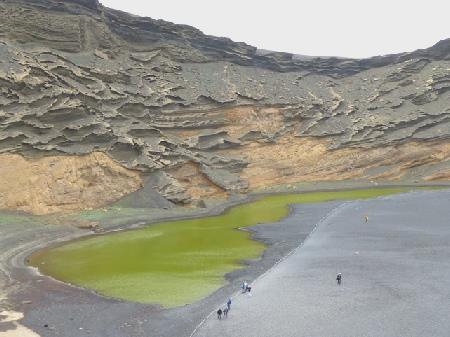
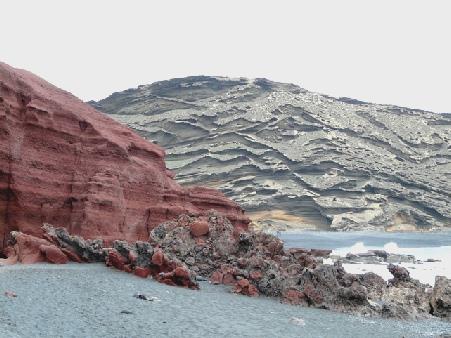
The green lagoon and strange rocks at El Golfo
A few miles further on we stopped at los Hervideros where there were walkways among the lava by the sea to see the water rushing up from below. This is best at high tide, but was still quite a fun thing to do. It had been constructed some time ago, and had seen better days, with some of the paths being closed off.
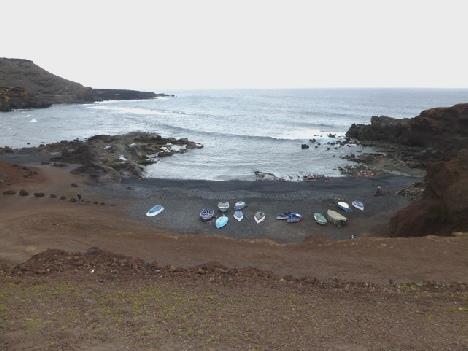
Little fishing boats at El Golfo
Once more there were lots of people but we had just returned to the car when the coach party arrived! The weather hadn't improved, and it had even tried to rain a bit!
A bit further along the coast we came to the once busy Salinas de Janubio. The salt from these salt pans was vital to preserve fish in the past. Now they are just an attractive sight and hardly used. There was a good viewpoint from the restaurant car park (closed Thursdays).
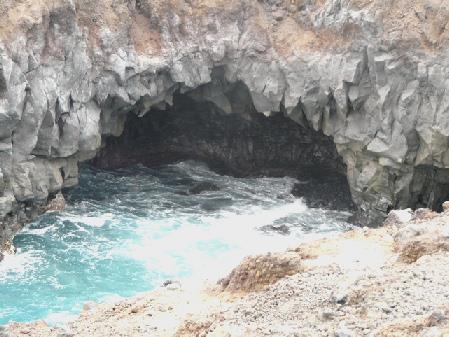

Surging sea at los Hervideros
We now drove past Yaiza and la Geria, arriving back at 5.30.
Adrian was asked to move the car, as a motorhome had arrived. Jurgen came in with a long length of cable to help with the unpredictable computer connection. When he found out that I spoke some German he became really chatty!
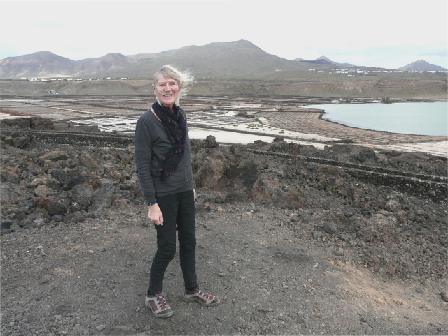

Salinas de Janubio
Friday 30th January To the far north of the island 93km
Continuing on our route, we came to some weird rock formations, like strange hoodoos, so stopped to walk amongst them and photograph them. The tiny purple and yellow flowers really set them off.
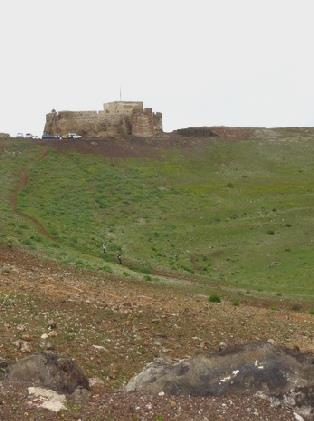
The photo that caused me a blow on the head!
We drove on past the cactus garden which we want to visit. It looked really busy, so we left it for later.
We were driving through the area of prickly pears, which are still grown for the cochineal made from the tiny beetles which live on them.
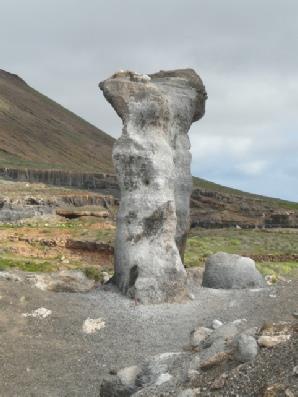
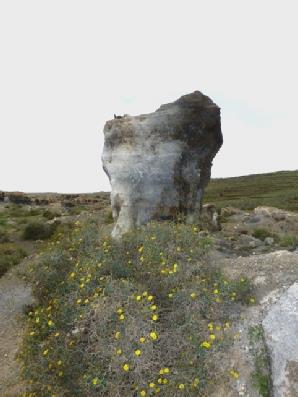
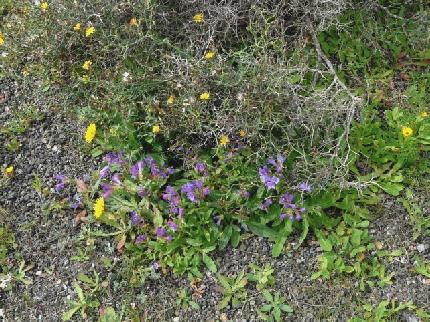
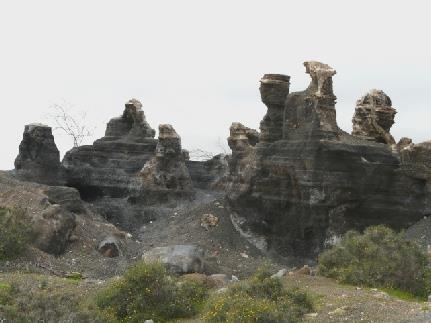
Flowers amongst the hoodoos
We made our way across, and walked along the beach in the wind. We could see across to Graciosa. Afterwards we had a cup of tea and shared a chocolate croissant. As we came back to Orzola we watched the ferry arrive back from Graciosa.
We soon stopped at another lovely sandy beach, but as we set off to walk to it, rain came on heavily – yuk!
We drove on down beside the coast, coming to Jameos del Agua. This was another of Manrique's legacies, and was quite delightful. At €9 each, it was a bit much, but the walk through a huge lava tube bedecked with tropical plants was wonderful. It was all very aesthetic, with atmospheric music being played. At the base was a pool of water where tiny white crabs live. The stairways were quite rustic, and without any handrails, so a bit dodgy for me! At the far end, we came to the exquisite sight of a turquoise pool with a white surround. A real treat for the senses, with the sea just beyond. Being late in the day, it was really quiet – the coach parties had left and just one or two people were sitting at the many strategically placed restaurant tables. A lovely visit.
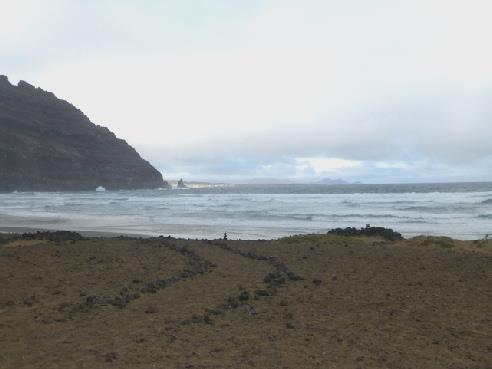
Playa de la Cantera, Orzola
We had been looking for a 'hole in the wall' to get some more money, but this was fruitless! We tried the Canarian coastal village of Punta Mujeres. It was nice to see a real 'local' place. Arriete had nothing either, so we gave up and headed back past all the prickly pears taking a different cross country route which was barely surfaced, through very green country to Teguise.
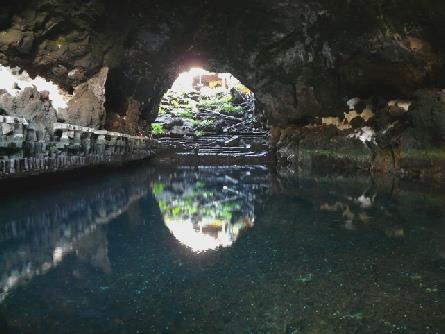
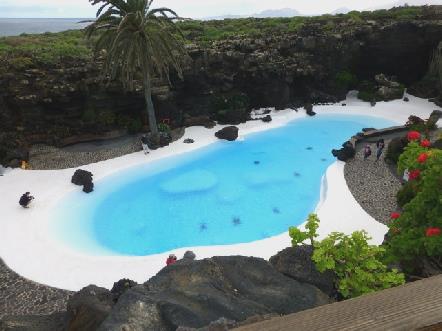
Lovely Jameos del Agua
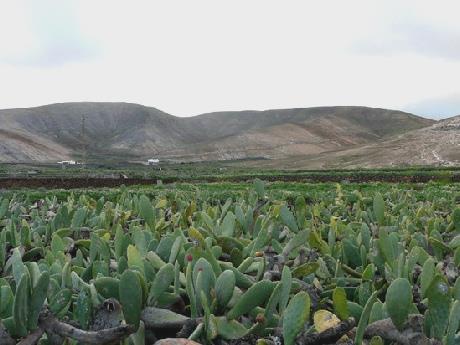
Fields of prickly pears
We arrived back at 6.15, where we soon had 'tea', listening to dear Desmond Carrington on the radio.
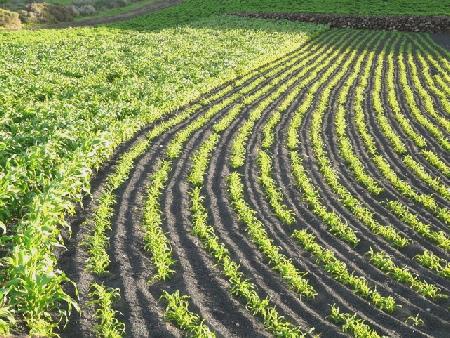

Crops and flowers beside the road
We enjoyed seeing the many different artefacts including all sorts of milling stuff. In one room we were given a small sample of wine.
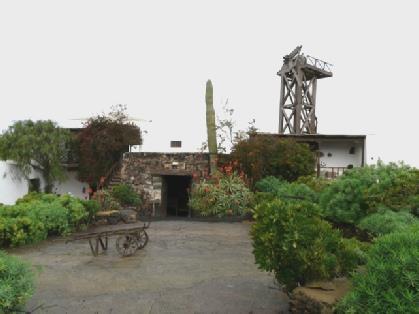



All told, it was an excellent €5 worth! Folk type music was being played over the speakers, and it all had a really nice feel. It just looked as though it needed some care and attention given to it to preserve what they have. By the time we'd finished our visit, it was lunch time, so we took our sandwiches to eat at the covered (from the sun usually) picnic area, watched by many of the chickens!
We now drove on to Tinago, where Adrian was able to get some money from a 'hole in the wall', and we then found a small, crummy little supermarket to buy one or two things, but no fish. I had noticed a fish shop a bit further back. We made our way there – Pescedaria Tenesar - it was now 1.55 and the shop closed at 2.00! The cheery fishmonger had cleared everything up – he just had two trays of enormous fish on the counter. We ended up buying some conger eel €3.20, so will have to see what that's like!
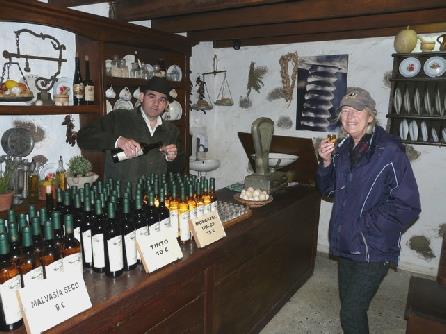
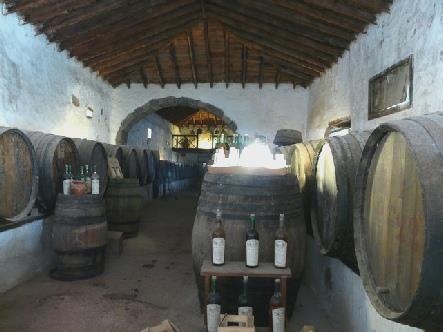

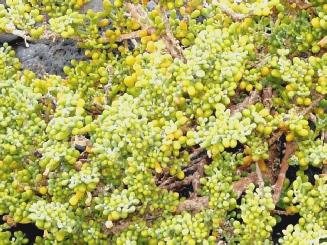

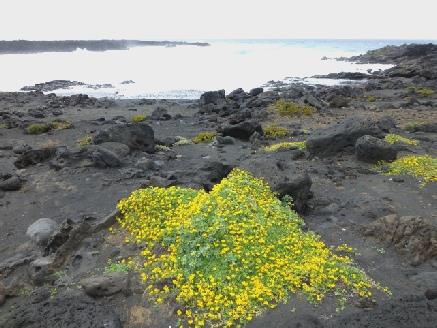
We drove back to another branch of the road, this bit tarmacked, coming down to the sea again at Tenesar – a small collection of white houses, most in a sad state of disrepair.
Marvellous Playa de las Malvas with wild flowers and sea grapes
We now drove on for a very long way across lava fields. After some way, the road became unsurfaced, but we continued for 5km to Playa de las Malvas. This was a superb beach of black lava with huge waves crashing from the turquoise sea. We picked our way over the rocks, enjoying the little flowers emerging from the black grit. There were many different types of yellow flowers, but also some white and some pink ones.
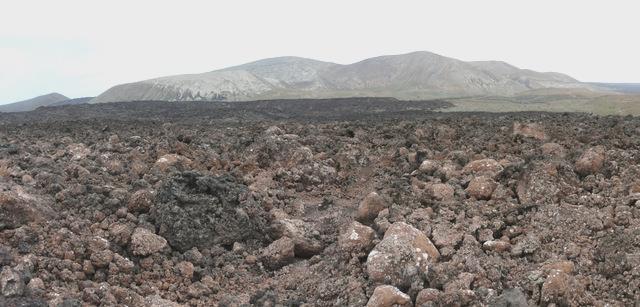
Parque Natural de Los Volcanoes
Having looked around, we drove back to Tinago, where we noticed a dragon tree – the first that we'd seen on Lanzarote.
We continued to la Santa, where Adrian looked at the little harbour, but I found it too windy.
Soon after this we drove around a small island joined by a causeway. It had roadways and beaches laid out, but nothing else – obviously a failed development, right next to the urbanisation of la Santa.
We drove on as far as Caleta de Cabello with its white and green (and sometimes blue) houses, but it was totally dead.
We now drove back, arriving at 5 o'clock, wondering what state we would find our place in. What a lovely surprise to see a bottle of cava on the table with two glasses! The bed had been pulled out and there were clean towels and bedding.
We enjoyed our bubbly, and later I made a mushroom omelet.

A smart bit of Tenesar
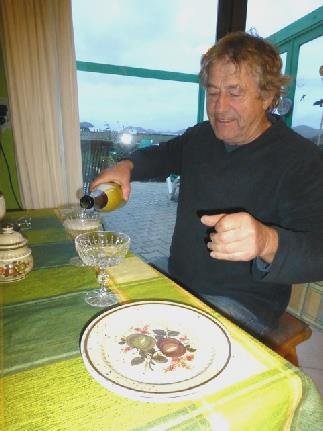
Sunday 1st February A vast market, lovely cacti and some sunshine! 63 km
The morning was brighter but it was cloudy by the time we left at 10.00. The lady in the motorhome asked if it had been wet all over the island yesterday!
The Sunday cyclists were out as we drove to Teguise. We knew that there was a large market here on Sundays, but were surprised at how large! The whole of the centre of the town was closed to traffic, and people were parking a long way out. We managed to find somewhere to park not far from the centre then followed the crowds. The market was vast, but not very exciting. It was mostly just clothes – shoes, belts, hats – and also small toys. We didn't find any local produce. It was cool and windy, but despite this many people were dressed in their 'holiday gear'! All we bought was some aloe vera soap and some churros, which we ate when we got back to the car. We sat on a seat with our drink – the weather was now warm, with a blue sky for the first time!
We then made our way to the cactus garden started by Manrique at Gautiza. This was set in a quarry and certainly contained some prime specimens of lovely cacti. Entrance was €5.50. We walked around the terraces – in true Manrique style, there were no barriers, which with the rough lava ground made me rather wary. Beautiful as it was, it seemed too neat and organised for us. Luckily there weren't too many other visitors - a coach party dashed around, but we could take our time.
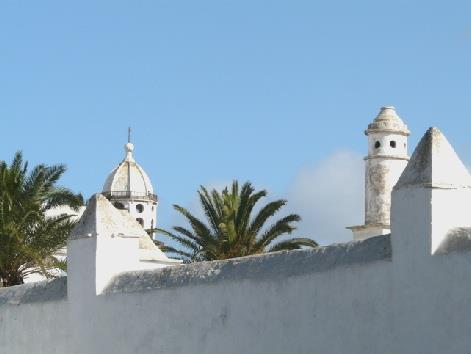
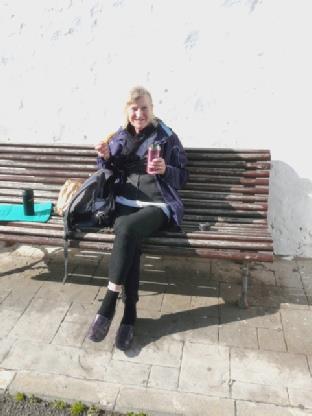
What’s this blue sky?
Afterwards we drove down to the sea at los Cocoteros where we ate our sandwich lunch sitting on rocks by a sea water pool next to the sea. It was sheltered in our isolated spot and we even had some hot sun!! We lazed a bit on the black sandy beach. I'd tried the water, but it was quite cool!

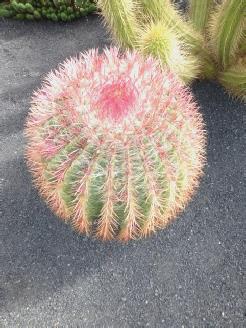

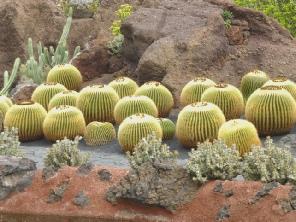
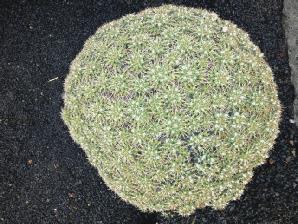
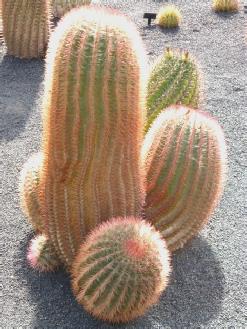
Some of the wonderful cacti at Manrique’s cactus garden
We left here at 2 o'clock and drove to the capital of Lanzarote, Arrecife. This was really quiet on a Sunday afternoon, and VERY windy. We walked across on a causeway to Castillo de San Gabriel, which we knew was closed today, and back on another causeway, but it was too windy for me to enjoy.
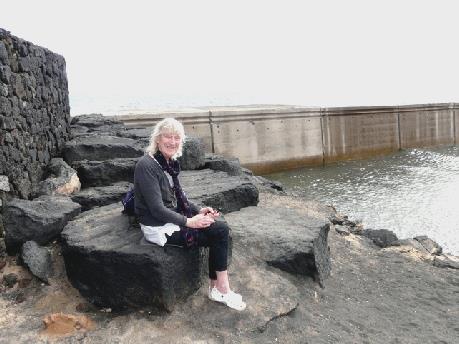
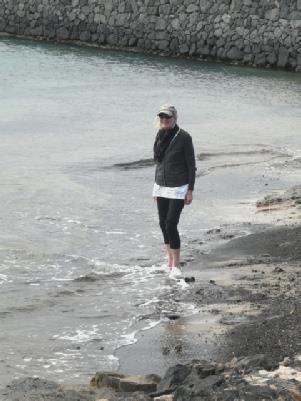
los Cocoteros
We walked around part of the deserted town and peeped into dark St Gines church, where music was playing. I wasn't enjoying the wind, so we left here at 3 o'clock, arriving back at 3.45, hoping to sit on the patio in the sun, but it had now become quite cloudy again although the sun did come out briefly. We had seen a bird as we got back, which we looked up to be a southern grey shrike. There was a lovely sky as the sun went down.
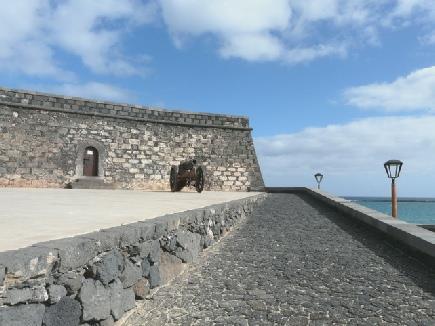

Castillo de San Gabriel, Arrecife
Monday 2nd February To some idyllic sandy beaches 92 km
We didn't rush off, working a bit more on the website, and leaving late morning. Just as we were about to leave, Jurgen came over and gave us contact information for magnetic laser treatment which he thought might help my tumour, as it had cured a relative. Adrian had mentioned to Elke yesterday about my 'problem', but wasn't sure that she had understood.
The sky was mixed, but it was a dry and pleasant day. We drove through San Bartolome, stopping to visit the bakers, where we bought filled rolls and a loaf. It was also a cafe, and several cyclists were enjoying morning coffee here, and visiting the cycle shop next door. We also went into a little greengrocers store and Adrian got some more pears. He then drove round in circles trying to get out of the town because of the one-way system. When we had, we headed towards Puerto Calero, which is where Ruby said that she had stayed last year. We found it difficult to find our way there, and when we did, there was no access to the sea, you just stopped beside a marina. This wasn't much fun for us, so we drove back a bit to eat our lunch. We now headed for Playa Quernada, which was more what we were looking for. On the way, the ground was covered in carpets of lilac coloured and yellow flowers.
I cooked the conger eel for supper then we worked some more on the website.

Playa Quernada consisted of a few white houses and two simple fish restaurants beside the black stony beach. It made us think of Pozo Negro in Fuertventura – lovely and unspoilt.
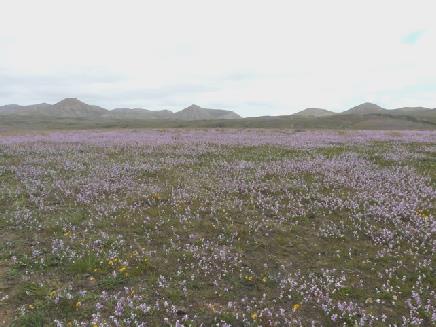
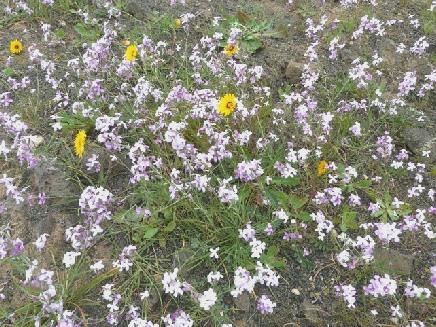
Carpets of flowers

Playa Quernada
We drove on to Caleta del Congrio, where we were amazed to see what looked like a large campsite laid out beside the beach. There was just a neat array of electric points and a toilet block. No shade at all – and where would 150 or so campers come from we wondered. It was deserted. (When we got back , Adrian looked up on the computer and found a photo with the car park and campsite actually packed out with locals. We also found out that this used to be a nudist beach!)
We walked across to a delightful beach, making us think of Cornwall. We had taken our flasks with us, and sat in our almost isolation.


Two of the lovely Papagaya beaches
Now it was time to return. We drove through vast Playa Blanca and then on through Femes and la Geria 'vineyards', arriving back at 5.45. We found the bits of washing we had hung up outside scattered on the ground!
I made a soup with the extra bit of conger eel the fishmonger had given us and then we worked more on the website.
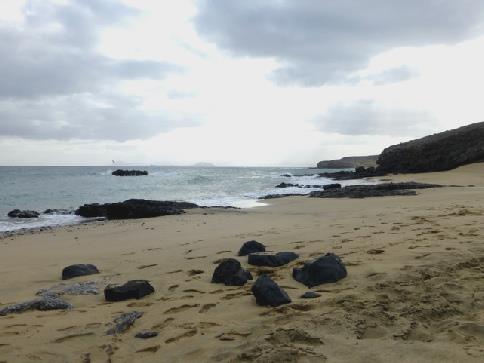
Caleta del Congrio, Papagaya
Tuesday 3rd February Timanfaya National Park and 'Omar Sharif's house' 79 km
On our return, we looked in at the restaurant (Manrique again) where meat was cooked on a huge barbecue using heat from the volcanic ground below. Large windows gave views over the lava fields, but we drove down to a carpark at the edge of the park to eat our sandwiches. This is where camels take people for a ride across the lava. The lines of camels looked very atmospheric, but no-one came back smiling – perhaps it was a bit chilly and damp! People rode on a seat either side of the camel, not on it's back, as we have done in India and Australia.


Timanfaya National Park
We left here, and drove to la Caleta de Famara, a simple coastal village of white houses edged with green and blue at the foot of the vertical Famara cliffs we had driven along the other day. Some of the roads in the village were unsurfaced. We realised that this was a surfing place, but the red flags meant no surfing today. Next door was the low-rise urbanisation we had looked down on from above before.
Now it was time to make our way to Nazaret and 'Omar Sharif's house'. This turned out to be more fun than we'd imagined. Difficult to describe, it was set into cliffs with steps going here and there, so that you never knew what you would find. It was the project of Soto, in collaboration with Manrique. There were occasional handrails, but the going wasn't the best for me, although we both really enjoyed our visit. There were nooks and crannies everywhere, often with seating. It seems that Omar Sharif only owned the place for one day, having lost it over a game of bridge!
There were two inviting pools, which must have been difficult to ignore on a hot day! There were only a couple of other visitors at this time of day. Two young German girls were loving it, especially the one of about seven, saying 'what will we find next?'
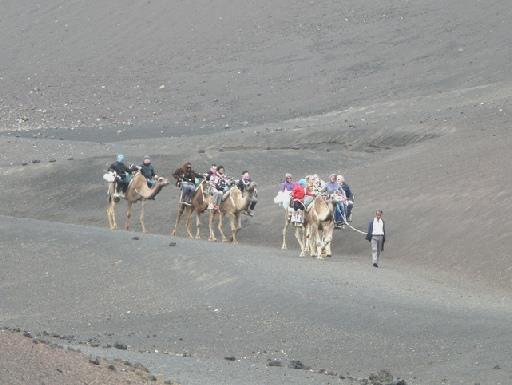
Watching the camel safari
We made our way back to our place, arriving at 4.45.

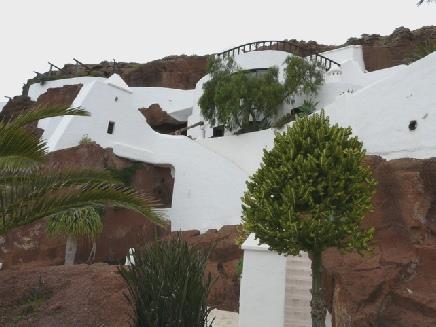

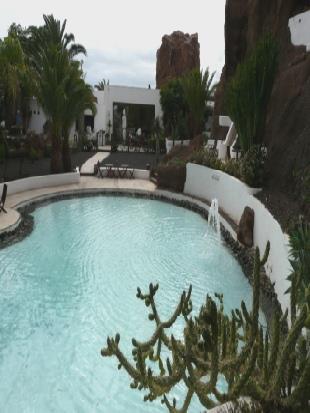
‘Omar Sharif’s house’, Nazaret
Wednesday 4th February A hairy cave and Manrique's house 68 km
An overcast day for our last full day on Lanzarote.
We looked in again at the pool when we left at 10.20, but the water felt cool and was an uninviting brownish colour. Shame!
We stopped at the English bakery in Teguise, which is always well patronised, although we think expensive. Once again there were a lot of cyclists about.
We drove to Cueva de los Verdes, an underground lava tube. We paid our €9 each, and were told to join the line of people just leaving. No instructions or anything – nothing to warn you of the rather hairy nature of this trip!
We joined about 50 others, including a few small children and babies, to make the trip down numerous uneven steps and through extremely low and narrow gaps for about 1km before finally coming to an auditorium where concerts are sometimes performed. Our guide spoke Spanish and English, but his voice was so quiet and monotonous that it was difficult to know what he said. At the end point, he invited someone to throw a small rock into the water which we thought far below, but in fact was a deceptive shallow pool, so still that we were all fooled and surprised. We were in there for almost and hour, so I felt very proud!
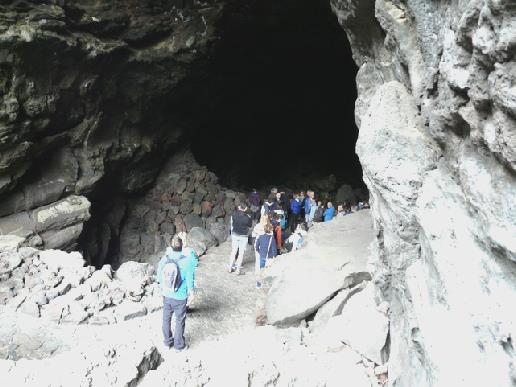
Going down into the lava tube
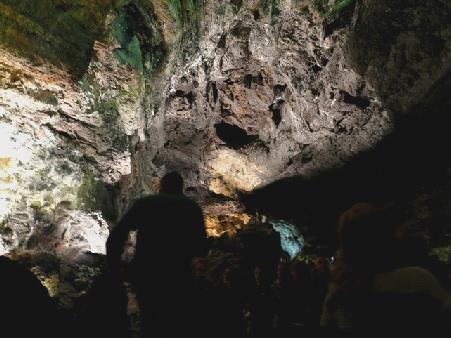
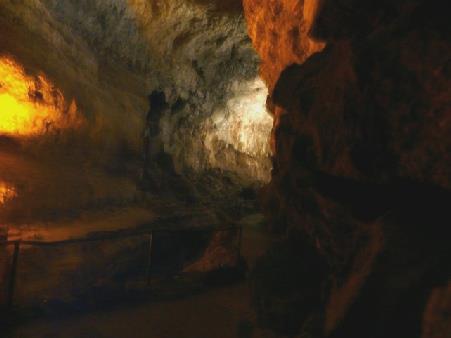
Inside Cueva de los Verdes
We stopped at Manrique's house in Tahiche – set out as a museum now displaying some of Manrique's work, including a couple of his very innovative 'wind chimes'. Like the 'Omar Sharif' house, it was very different and interesting. It is set amongst lava fields, and incorporates the lava as part of the house. Maybe not quite so much fun as the other house, there was still plenty to amuse us. Cacti grew in the vast 'garden' outside, and we sometimes walked through tunnels in the lava to get from one 'room' to the next. A fun visit. A coach arrived just as we left, so we got that one right!
We got back at 4.45, bringing everything in from the car to sort out ready to leave for Barcelona tomorrow. We'd been hoping to sit on the patio in the sunshine, but sadly the sky was now overcast again. We still sat out with a beer.
We played a high scoring game of yahtzee, in which Adrian got 3 yahtzees! and an equally high scoring 5s&2s. We did today's website as we drank our surplus sherry and G&T!
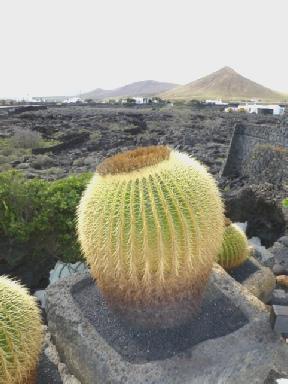

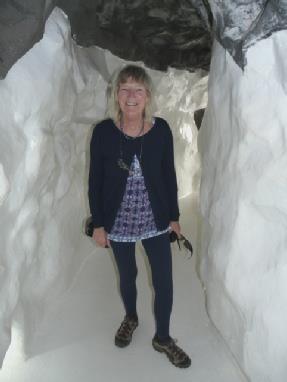

Manrique’s home, now a foundation
Thursday 5th February A lovely last lunch in the sun, then on to Barcelona 44 km
It was an overcast but pleasant morning. We had a good breakfast of fried Canarian potatoes before getting packed up and sorted. We left at midday, saying goodbye to Elke and Jurgen, who were genuinely concerned for my health. They didn't charge us for the heating, to make up for our upset with the leaking roof.
We drove the short way to the Monumento Campesino, Manrique's monument to the people, where there were supposed to be lots of artisans at work. Again this was a posey affair, very modern and with few handrails on the many stairs, and with almost nothing to see. We climbed up to the monument, where we could look back to the house we had stayed at.
We had intended eating lunch at the restaurant here, but it was a smart, touristy place, not for us at all!
We made the joint decision to drive down to Playa Quernada, the pleasant unspoilt beach where we had seen a restaurant beside the sea the other day. We were not disappointed! The place we chose (there were a couple of others) was constantly busy, but we were lucky enough to get a table at the front in the now warm sunshine! Adrian's fresh sea bass was first class, and my prawn and avocado dish was just right. We each had a beer and really enjoyed our last meal on Lanzarote, and the Ron miel which came with the bill. The owner/waiter didn't waste a trick in trying to entice customers in, but quite pleasantly so.
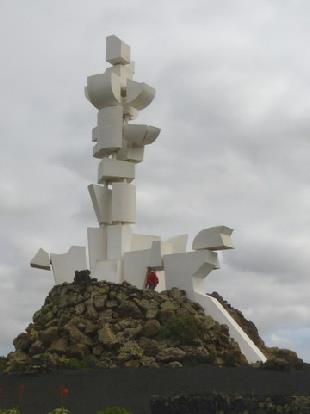

Monumento Campesino
We didn't want to leave this sunny spot, but at 2.30 we made our way towards the airport at Arrecife, stopping to get some fuel, so as to leave the tank full.
We located the place to leave the car and checked in. Adrian's hand luggage went into the hold, as the plane was full, so we transferred a few of his things. As we went through security, the officials appeared to be looking the other way, so no hassle there!
In fact everything was OK, except for the usual annoyance of having to throw away our bottled water and then buy some after security at great expense.
We were flying with Ryanair for the first time, but despite our concerns it was fine, apart from being slightly more cramped, and having no pocket in front to put things.
Soon after taking off, the weather became cloudy, but did clear as we flew over the sea and then over Spain, but by now it was dark and we could just see the lights of the many towns we flew over.
We had taken our Ipod and headphones, and enjoyed listening to the first song when the battery went flat!
Next to us was Spanish lady in brightly coloured top and with her grey hair streaked with purple. When she got up for the loo, I decided to go too, (wondering if you had to pay, as we'd heard that Ryanair was charging for toilets). No, it was fine, but when we returned to our seats, the lady said that her bottle of water had gone from her seat. She was most upset, and seemed to think that we had taken it. Shortly before landing, I found the bottle under my seat. She still seemed to blame us!
We landed at Barcelona at around 8.40pm, having had to move time on one hour. Once reunited with all our luggage, we were greeted by Tom, who had come to collect us in his new car. He told us that it had been really cold in Sitges too, with snow, which had caused many travel problems.
He drove us back to Sitges, where we booked into Hostal Bonanza, where we had stayed 18 months ago in rather different weather!
Our room was small, and with few facilities, particularly in the bathroom, which had no hooks for the towels, but was adequate and clean.
Tom joined us for a beer downstairs before we came up to our room at about midnight Spanish time, looking forward to seeing Mar and 19 month old Rita tomorrow.
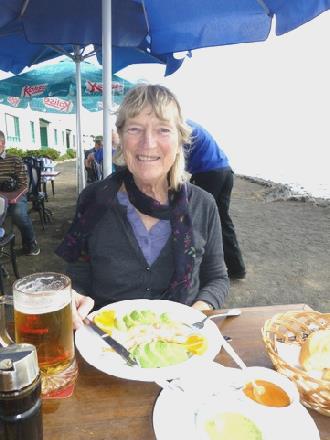
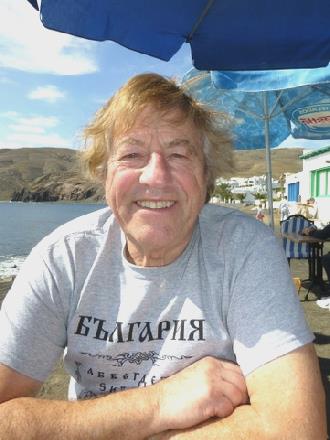
Lovely last lunch in the sunshine!
Friday 6th – Tuesday 10th February A lovely few days in Sitges
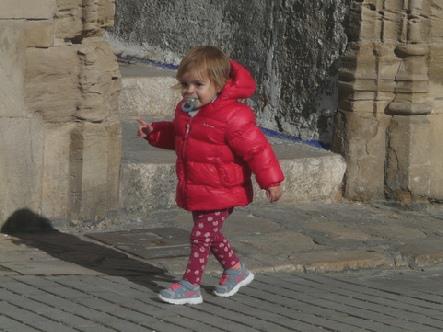
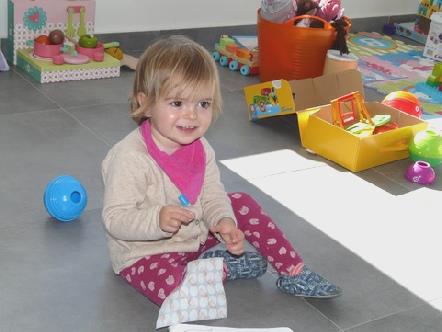
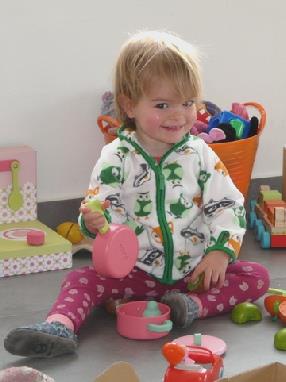
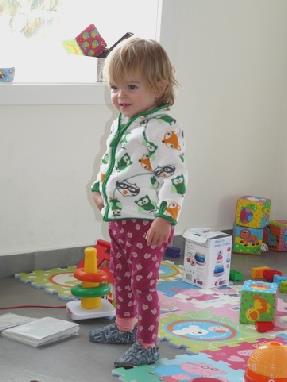
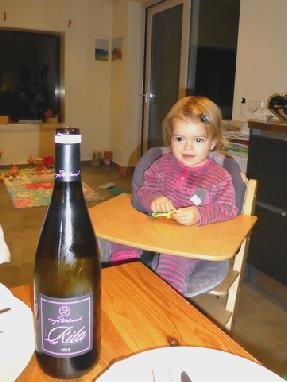



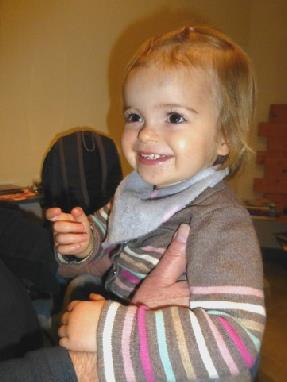

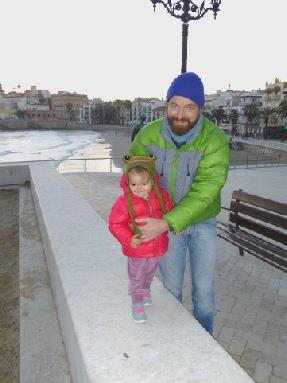
Tom & Adrian spent a 'boy's night', watching the football match between Barcelona & Athletic Bilbao downstairs in our hotel which was just up the road from Tom & Mar. Barcelona fortunately won 5 - 2. Adrian had refrained from shouting 'Messi, Messi, Messi', even though he had scored the first goal!
On the Tuesday, Tom collected our bags on his way to work, then Mar called in for Rita to say goodbye on her way to Nursery.
Later we walked down to see Mar. Her mum came in to say goodbye. We walked to the station and caught the train to Castelldefels, where Tom collected us during his free period and drove us to the airport at Barcelona which we were very grateful for.
All was well on the flight. We saw snow on the Pyrenees, then the weather clouded over as we headed northwards over France. It was cloudy when we landed at Gatwick. By 4.00pm we were on our way home, and despite traffic being a bit slow on the M25, we arrived at Hermitage at 5.45pm.
Sitges was sunny, but the mornings and evenings were very cold. It was great to catch up with Tom, Mar and delightful little Rita. We hadn't seen her for 6 months, when she was still a baby. Now she is a little girl, running everywhere, and showing her character and her likes/dislikes by a tiny nod or shake of her head! We were able to look over the ground floor apartment which Tom & Mar are hoping the buy, which will give them much needed extra space, but will entail complete renovation.
We visited the newly refurbished museum in Sitges, and the excellent railway museum in nearby Vilanova, joined by Mar's dad Pere. This was a real treat for them!
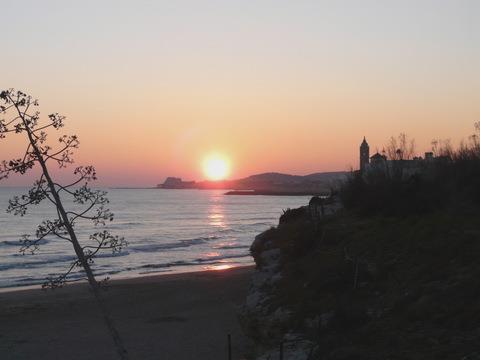

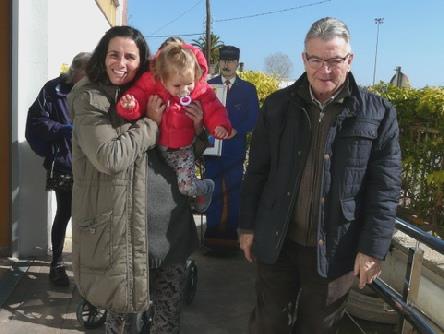
We had set the alarm for 4.00am, but were awake and up at 3.45. We left at 4.30 as planned. It was dark as we drove to Gatwick, but there had been no frost, which we were glad about. Huge snow storms had been forecast for eastern USA. We had a trouble free journey, being surprised at the amount of traffic even at this early hour.
We'd had contact from all of our 'children' yesterday, and I'd called in to see Mary next door as she's moving next week, after dear Jim had died last year.
We were using 'I love Meet and Greet', and tried twice to phone as we neared Gatwick, but the phone cut out both times so we made our way to the place we'd stopped at with previous 'meet and greet' firms. Our chap soon dashed over and told us that we were in the wrong place, and a traffic warden was coming. Luckily he was a friendly one, and let us stay there to unload our bags.
All went well at Gatwick, with the staff being very pleasant. We had used our new little flasks from Emma to have a warm drink before going through security. Once through, we ate the sandwiches we'd made at home for our breakfast.
Adrian wanted to get some computer magazines, so I went off, looking in at a crowded Boots and then Accessorise, which had some really pretty, if expensive, goods. I bought myself a lovely little sunhat (children's size), which I'd been wanting.
When I met up with Adrian, he was quite anxious, as our gate number had been called and it was a long walk I'd heard the announcement for 'Arrecife' and had thought 'I wonder where that is'! Luckily we hadn't started off before the gate number was up, like we have done before, as Adrian was sure that Easyjet always went from a certain departure gate. This time, however, it was from a different one! It was still a very long walk. Although we put 'assistance' on the booking, I would rather walk.
Our flight was fine – we even had a free seat beside us. There was much cloud, but we did see the coast of Portugal. Once over the sea again, we had a long stretch of turbulence. I had started reading the book Kon Tiki, by Thor Heyerdal. We'd recently seen the excellent film. The story has always fascinated me, especially as Thor Heyerdal had spent a year on the Marquesan island of Fatu Hiva before setting out on his trip.
Before we knew it, we were descending to Lanzarote. We landed at Arrecife at 11.20, enjoying the blue sky and the little white houses.
We got through immigration quickly and collected our bags. We made our way to our Car Hire, having a bit of trouble in finding the right way. Adrian thought the assistant not very helpful, and after walking off, realised that he hadn't got any paperwork. After finding our car, he returned, where the lady said 'I turned round and you'd gone'. The queue was really long now, so we were lucky.
We set off, having the usual problems with a different car, and unfamiliar territory. It was now gone midday, and we needed to buy some food, so when we passed a 'Eurospar', in we went. Having stocked up with at least stuff for today, we made our way to Mozaga. We knew that our accommodation was near the monument – one of Manrique's (more of him later) many legacies. We could have phoned the owners, but Adrian drove around trying to find 'Casa Sandra'. When we realised that there were no house names, we pulled in where he thought the house was, and we asked a man who was taking loo rolls from his car. This, it turned out, was Jurgen, a dour German of about our age, and the owner. He pointed to where to park, and we found our way to our simple dwelling.
It is just one long room, with a bed tucked into the end, and opening onto a simple patio. Jurgen helped Adrian bring the bags in and we then had a late lunch sitting on our little patio.
We'd had contact from all of our 'children' yesterday, and I'd called in to see Mary next door as she's moving next week, after dear Jim had died last year.
We were using 'I love Meet and Greet', and tried twice to phone as we neared Gatwick, but the phone cut out both times so we made our way to the place we'd stopped at with previous 'meet and greet' firms. Our chap soon dashed over and told us that we were in the wrong place, and a traffic warden was coming. Luckily he was a friendly one, and let us stay there to unload our bags.
All went well at Gatwick, with the staff being very pleasant. We had used our new little flasks from Emma to have a warm drink before going through security. Once through, we ate the sandwiches we'd made at home for our breakfast.
Adrian wanted to get some computer magazines, so I went off, looking in at a crowded Boots and then Accessorise, which had some really pretty, if expensive, goods. I bought myself a lovely little sunhat (children's size), which I'd been wanting.
When I met up with Adrian, he was quite anxious, as our gate number had been called and it was a long walk I'd heard the announcement for 'Arrecife' and had thought 'I wonder where that is'! Luckily we hadn't started off before the gate number was up, like we have done before, as Adrian was sure that Easyjet always went from a certain departure gate. This time, however, it was from a different one! It was still a very long walk. Although we put 'assistance' on the booking, I would rather walk.
Our flight was fine – we even had a free seat beside us. There was much cloud, but we did see the coast of Portugal. Once over the sea again, we had a long stretch of turbulence. I had started reading the book Kon Tiki, by Thor Heyerdal. We'd recently seen the excellent film. The story has always fascinated me, especially as Thor Heyerdal had spent a year on the Marquesan island of Fatu Hiva before setting out on his trip.
Before we knew it, we were descending to Lanzarote. We landed at Arrecife at 11.20, enjoying the blue sky and the little white houses.
We got through immigration quickly and collected our bags. We made our way to our Car Hire, having a bit of trouble in finding the right way. Adrian thought the assistant not very helpful, and after walking off, realised that he hadn't got any paperwork. After finding our car, he returned, where the lady said 'I turned round and you'd gone'. The queue was really long now, so we were lucky.
We set off, having the usual problems with a different car, and unfamiliar territory. It was now gone midday, and we needed to buy some food, so when we passed a 'Eurospar', in we went. Having stocked up with at least stuff for today, we made our way to Mozaga. We knew that our accommodation was near the monument – one of Manrique's (more of him later) many legacies. We could have phoned the owners, but Adrian drove around trying to find 'Casa Sandra'. When we realised that there were no house names, we pulled in where he thought the house was, and we asked a man who was taking loo rolls from his car. This, it turned out, was Jurgen, a dour German of about our age, and the owner. He pointed to where to park, and we found our way to our simple dwelling.
It is just one long room, with a bed tucked into the end, and opening onto a simple patio. Jurgen helped Adrian bring the bags in and we then had a late lunch sitting on our little patio.
Cesar Manrique is probably the most famous ‘father’ of Lanzarote. A multi-talented man - he was a painter, sculptor, architect and writer - he had been born in Arrecife in 1919. He had lived in Madrid and USA, but returned to Lanzarote when the tourist boom came in the sixties determined to stop Lanzarote from being badly developed.
When we got back, passing a little shop where we were able to get a large bottle of drinking water, the sun was soon going down prettily behind one of the volcanoes. It was time for a 'sundowner', but again we had problems. Adrian hadn't been able to get any sherry for me. I settled on a white wine, but he couldn't get the cork out, despite his marathon efforts, so I had to settle on an 'uncold' one. There was no freezer tray, so no ice for Adrian's G&T.
The evening had become really cool after the sun had gone down. Adrian went to ask if we could have the heating (an optional extra) but was told that it was too late for tonight, as it took a while to get going. A bit later Jurgen brought a heater over.
I cooked trout for supper and we had a fairly early night.
When we got back, passing a little shop where we were able to get a large bottle of drinking water, the sun was soon going down prettily behind one of the volcanoes. It was time for a 'sundowner', but again we had problems. Adrian hadn't been able to get any sherry for me. I settled on a white wine, but he couldn't get the cork out, despite his marathon efforts, so I had to settle on an 'uncold' one. There was no freezer tray, so no ice for Adrian's G&T.
The evening had become really cool after the sun had gone down. Adrian went to ask if we could have the heating (an optional extra) but was told that it was too late for tonight, as it took a while to get going. A bit later Jurgen brought a heater over.
I cooked trout for supper and we had a fairly early night.
We continued through pleasant looking Maquez, past volcano Monte Corona, turning off to Guinate. We drove past the zoo to the Mirador de Guinate. There were just one or two cars here, and no room for coaches! We had lovely views across to the island of Graciosa.
We enjoyed a cup of tea sitting on the wall above the steep cliffs.
We enjoyed a cup of tea sitting on the wall above the steep cliffs.
It was a mixed day again with mostly cloud and even a little rain! Now that we've accepted that the weather isn't good, it doesn't seem so bad.
At least we could listen to radio 2 while we had breakfast, with our better internet connection.
We left late morning, stopping to chat to the German lady in the motorhome who has come away for 7 months!
We had decided to drive north today, We stopped at the really busy English bakers in Teguise and bought a loaf and croissants.
We came to the road up to Castillo Santa Barbara, which now houses the pirate museum, and drove up there for the view. It was certainly in a splendid location, right on the side of a large volcanic crater. It was a fitting place to house a museum on pirates, as islanders had hidden here when pirates had attacked the islands in the past. As we drove back past the crater, we stopped so that I could take a photo looking back to the castle. As I stepped out of the car, the strong wind took my hat. In trying to stop it, I crashed my camera on to my head! I wasn't happy! The photo wasn't very good anyway!
At least we could listen to radio 2 while we had breakfast, with our better internet connection.
We left late morning, stopping to chat to the German lady in the motorhome who has come away for 7 months!
We had decided to drive north today, We stopped at the really busy English bakers in Teguise and bought a loaf and croissants.
We came to the road up to Castillo Santa Barbara, which now houses the pirate museum, and drove up there for the view. It was certainly in a splendid location, right on the side of a large volcanic crater. It was a fitting place to house a museum on pirates, as islanders had hidden here when pirates had attacked the islands in the past. As we drove back past the crater, we stopped so that I could take a photo looking back to the castle. As I stepped out of the car, the strong wind took my hat. In trying to stop it, I crashed my camera on to my head! I wasn't happy! The photo wasn't very good anyway!
We now drove on through more vast areas of lava to El Golfo, a small fishing village on the coast. This seemed very busy - Adrian hated the vast number of coaches, something we didn't see on Fuerteventura. We imagine that the bad weather meant that people were unable to lie on the beach, so were driving around or taking a coach tour.
We drove to the end of the road, and stopped beside a beach of black lava. We walked up through the lava on a rough path near the sea.
We drove back through El Golfo, where there were a lot of restaurants – there are supposedly good fish restaurants here.
At the other end of the village we walked along to see a strange green lagoon beside the sea.
We drove to the end of the road, and stopped beside a beach of black lava. We walked up through the lava on a rough path near the sea.
We drove back through El Golfo, where there were a lot of restaurants – there are supposedly good fish restaurants here.
At the other end of the village we walked along to see a strange green lagoon beside the sea.
Just as we reached Arriete, we turned off on a track to the wild beach which surfers were enjoying. There was a remote restaurant here so we thought that we'd give it a try. A few people were sitting outside, but we opted to sit inside with views of the crashing waves. In fact we moved tables at the last minute for a better view. My seafood soup and Adrian's sole with Canary potatoes were excellent, washed down with a local beer. It was all reasonably priced, and we were given a Ron Miel too. Much more successful than the other night!
It was 2 o'clock when we left here, driving on past Manrique's wind chime sculpture, towards Orzola at the far north of the island. This is where the ferry leaves from for the nearby island of Graciosa, which I would love to visit, but even the guide book says that you need good sea legs!
Orzola is an attractive little town of white and green, and also sometimes blue too. It was asleep except for a few restaurants. We passed some disused salinas. Having had a look at the town, we started driving back, taking a track off to Playa de la Cantera, a pretty beach beneath high black cliffs. A pathway was marked by pebbles, but stopped as you got to the large black stones before the white sand!
It was 2 o'clock when we left here, driving on past Manrique's wind chime sculpture, towards Orzola at the far north of the island. This is where the ferry leaves from for the nearby island of Graciosa, which I would love to visit, but even the guide book says that you need good sea legs!
Orzola is an attractive little town of white and green, and also sometimes blue too. It was asleep except for a few restaurants. We passed some disused salinas. Having had a look at the town, we started driving back, taking a track off to Playa de la Cantera, a pretty beach beneath high black cliffs. A pathway was marked by pebbles, but stopped as you got to the large black stones before the white sand!
At 7.00am I felt drips on my face, and realised that water was dripping onto the bed. The bathroom floor was wet too! We got up and moved things. Adrian wasn't able to move the bed out from its place tucked in the alcove. The morning was grey and wet, so altogether not much fun!
We spent a long time trying to get hold of Jurgen and Elke to tell them. We spoke to the lady in the next 'room' to us. She only spoke German, but said that it hadn't been wet like this for 50 years! We spoke to the lady from the motorhome too, and finally, just before we left at 11.00, we were able to speak to Elke and tell her of the problem.
We couldn't then get out of the drive, as a huge long line of children was walking past, with a police escort stopping the traffic. We can only think that it was a walk (what a day!)
It was very bad visibility as we drove to Tiagua. The sun did try to peep through, but the day was really grey with frequent rain.
We stopped at El Patio museum in Tiagua and had a very nice visit. The museum was set in a former large farm, and as it wasn't raining when we arrived, we looked at the outside exhibits first. One small enclosure had a camel surrounded by goats. Chickens of all shapes and sizes wandered around freely. A windmill, minus most of its sails, stood above the yard. There were lots of large and attractive cacti and other nice plants. Information was written in English as well as Spanish and German.
We spent a long time trying to get hold of Jurgen and Elke to tell them. We spoke to the lady in the next 'room' to us. She only spoke German, but said that it hadn't been wet like this for 50 years! We spoke to the lady from the motorhome too, and finally, just before we left at 11.00, we were able to speak to Elke and tell her of the problem.
We couldn't then get out of the drive, as a huge long line of children was walking past, with a police escort stopping the traffic. We can only think that it was a walk (what a day!)
It was very bad visibility as we drove to Tiagua. The sun did try to peep through, but the day was really grey with frequent rain.
We stopped at El Patio museum in Tiagua and had a very nice visit. The museum was set in a former large farm, and as it wasn't raining when we arrived, we looked at the outside exhibits first. One small enclosure had a camel surrounded by goats. Chickens of all shapes and sizes wandered around freely. A windmill, minus most of its sails, stood above the yard. There were lots of large and attractive cacti and other nice plants. Information was written in English as well as Spanish and German.
Now we drove through Femes, at 1475ft, with great views towards Papagaya, on the southern tip of the island, where we were heading.
We had to drive on a stretch of very corrugated unsurfaced road before reaching the toll booth, where we paid €3 to drive on more bumpy roads through Monumento Natural de los Ajaches to reach some spectacular beaches.
We stopped at the first one, Playa Mujeres. A man from a small English group got unexpectedly wet , and in a Brummy accent said that the water was 'loyk oyce'! It was a beautiful sandy beach, with just a few other people. We had views across to Fuerteventura.
We drove on to Papagaya point, where more vehicles were parked above several idyllic looking sandy coves with the turquoise sea beyond. It was mostly sunny, but too windy for me as we walked around.
We had to drive on a stretch of very corrugated unsurfaced road before reaching the toll booth, where we paid €3 to drive on more bumpy roads through Monumento Natural de los Ajaches to reach some spectacular beaches.
We stopped at the first one, Playa Mujeres. A man from a small English group got unexpectedly wet , and in a Brummy accent said that the water was 'loyk oyce'! It was a beautiful sandy beach, with just a few other people. We had views across to Fuerteventura.
We drove on to Papagaya point, where more vehicles were parked above several idyllic looking sandy coves with the turquoise sea beyond. It was mostly sunny, but too windy for me as we walked around.
We left at 10.20 on a day with mixed sky. The German lady next door said goodbye as she was going back to Germany today. Shame – we were going to give her our large spare bottle of drinking water!
We headed towards the National Park of Timanfaya, stopping at the Visitors Centre at Mancha Blanca. This is the place where the lava stopped flowing after the eruptions of 1730-36, covering several villages, including Timanfaya. The Visitors Centre was very posey and modern, but did have a lot written in English on Lanzarote and elsewhere.
We made our way to the actual National Park, a vast volcanic area. You can't drive around by car, but have to go by bus. The 45 minute tour is included in the price of entry to the park - €9 each. We had to wait quite a while before being allowed to drive on to the car park which was packed. We soon got on to our coach, which filled up completely. The taped commentary started in Spanish, but was also in English and German. It reminded us of a tour we made in Tunisia some years ago. Again the information was given in 3 languages. An embarrassing Englishman (who we disowned) said 'Why is he saying all that, we can't understand a flipping word he's saying'.
The coach set off along the narrow roads between the lava. We had views, but only ever stopped briefly, and we weren't able to get out. Coach tours aren't Adrian's favourite, we prefer to 'do our own thing', but it was good to have visited.
We headed towards the National Park of Timanfaya, stopping at the Visitors Centre at Mancha Blanca. This is the place where the lava stopped flowing after the eruptions of 1730-36, covering several villages, including Timanfaya. The Visitors Centre was very posey and modern, but did have a lot written in English on Lanzarote and elsewhere.
We made our way to the actual National Park, a vast volcanic area. You can't drive around by car, but have to go by bus. The 45 minute tour is included in the price of entry to the park - €9 each. We had to wait quite a while before being allowed to drive on to the car park which was packed. We soon got on to our coach, which filled up completely. The taped commentary started in Spanish, but was also in English and German. It reminded us of a tour we made in Tunisia some years ago. Again the information was given in 3 languages. An embarrassing Englishman (who we disowned) said 'Why is he saying all that, we can't understand a flipping word he's saying'.
The coach set off along the narrow roads between the lava. We had views, but only ever stopped briefly, and we weren't able to get out. Coach tours aren't Adrian's favourite, we prefer to 'do our own thing', but it was good to have visited.
It was 12.30 when we emerged, where large groups were waiting their turn, so we had been lucky not to have waited. There were no facilities at all here – luckily we hadn't needed the loo!
We now drove back to Punta Mujeres and on to Arrieta, where we stopped at Chirinquito beach by the surfers, just along from where we'd eaten on Friday. There was a simple shack restaurant here too, and the weather was mild enough for us to sit outside. I had some delicious aubergine and excellent chips, which came with the fish croquettes, which weren't so good. Adrian's dorada fish was good too.
After our nice meal, we drove back and around to the other end of the beach and sat overlooking the waves. As we left, the sun broke through and for a few minutes it was hot!
We now drove back to Punta Mujeres and on to Arrieta, where we stopped at Chirinquito beach by the surfers, just along from where we'd eaten on Friday. There was a simple shack restaurant here too, and the weather was mild enough for us to sit outside. I had some delicious aubergine and excellent chips, which came with the fish croquettes, which weren't so good. Adrian's dorada fish was good too.
After our nice meal, we drove back and around to the other end of the beach and sat overlooking the waves. As we left, the sun broke through and for a few minutes it was hot!
Lanzarote 2015
Delightful El Patio Museum, Tiagua
Saturday 31st January Water! and a nice rural museum 64 km





